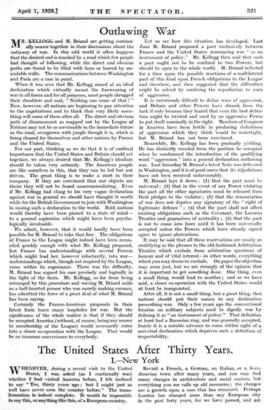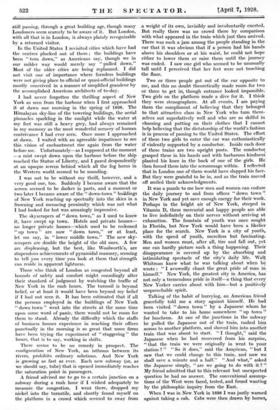The United States After Thirty Years.
1.—New York WHENEVER, during a recent visit to the United States, I was asked (as I continually was) whether I had visited America before, I felt inclined to- say " Yes, thirty years ago ; 'but I might just as 'well have never seen the country before." The trans- formation is indeed complete. It would be impossible to say this, or anything like this, of a European country. Revisit a French, a German, an Italian, or a Scan- dinavian town after many years, and you may find many changes in architecture and social custom, but everything you see calls up old memories ; the changes are a growth upon a core that has remained. Perhaps London has changed more than any European city in the past forty years, for we have passed, and are still passing, through a great building age, though many Londoners seem scarcely to be aware of it. But London, with all that is in London, is always plainly recognizable by a returned visitor.
In the United States I revisited cities which have had the centres plucked out of them ; the buildings have been " torn down," as Americans say, though we in our milder way would merely say " pulled down." Most of the older cities are being replanned. I did not visit one of importance where formless buildings were not giving place to official or quasi-official buildings mostly conceived in a manner of simplified grandeur by the accomplished American architects of to-day.
I had never forgotten the thrilling aspect of Nevi York as seen from the harbour when I first approached it at dawn one morning in the spring of 1898. The Himalayan sky-line of the towering buildings, the aerial pinnacles sparkling in the sunlight while the water at my feet was still a heavy grey, had always remained in my memory as the most wonderful scenery of human contrivance I had ever seen. Once more I approached at dawn. I waited with an agreeable impatience to see this vision of enchantment rise again from the water before me. Unfortunately—as I supposed at the moment —a mist swept down upon the harbour before the ship reached the Statue of Liberty, and I gazed despondently at an opaque screen behind which all the fog horns in the Western world seemed to be sounding.
I was not to be without my thrill, however, and a very good one, too. Suddenly I became aware that the screen seemed to be darker in parts, and a moment or two later I became aware of the " down-town " buildings of New York reaching up spectrally into the skies in a frowning and menacing proximity which was not what I had looked for but was amazingly impressive.
The skyscrapers of " down town," as I used to know it, have swept up town. Hotels and private houses— no longer private houses—which used to be reckoned " up town " are now " down town," or at least, let me say, in " lower middle town." The new sky- scrapers are double the height of the old ones. A few are displeasing, but the best, like Woolworth's, are stupendous achievements of pyramidal masonry, seeming to tell you every time you look at them that strength can reside in apparent lightness.
Those who think of London as congested beyond all bounds of safety and comfort might consolingly alter their standard of judgment by watching the traffic of New York in the rush hours. The turmoil is beyond belief, or at least it would have been beyond my belief if I had not seen it. It has been estimated that if all the persons employed in the buildings of New York " down town " went into the streets at the same time upon some word of panic, there would not be room for them to stand. Already the difficulty which the staffs of business houses experience in reaching their offices punctually in the morning is so great that some firms have been trying the experiment of " staggering " the hours, that is to say, working in shifts.
There seems to be no remedy in prospect. The configuration of New York, an isthmus between its rivers, prohibits ordinary solutions. And New York is growing as fast as ever. Each new subway (or, as we should say, tube) that is opened immediately reaches the saturation point in passengers.
A friend advised me to go to a certain junction on a subway during a rush hour if I wished adequately to measure. the congestion. I went there, dropped my - nickel into the turnstile, and shortly found myself on the platform in a crowd which seenied to sway from a weight of its own, invisibly and involuntarily exerted. But really there was no crowd there by comparison with what appeared in the train which just then arrived. There was such a jam among the people qtanding in the car that it was obvious that if a person had his hands above his shoulders or at his waist, he could not hope either to lower them or raise them until the journey was ended. I saw one girl who seemed to be unusually tall until I perceived that her feet were not touching the floor.
Two or three people got out of the car opposite to me, and this no doubt theoretically made room for two or three to get in, though entrance looked impossible: Two girls on the platforrn made a dive for it. I think they were stenographers. At all events, I am paying them the compliment of believing that they belonged to that attractive class in New York who turn them- selves out superlatively well and who are so skilful in choosing and putting on their clothes that I cannot help believing that the dictatorship of the world's fashion is in process of passing to the United States. The effort of these two girls to enter the car was enthusiastically if violently supported by a conductor. Inside each door of these trains are two upright posts. The conductor grasped these in his hands and with barbarous kindness. planted his knee in the back of one of the girls. He then forced them into the-scrummage within. I reflected that in London .one of them would have slapped his face. But they were grateful to be in, and as the'train moved off smiled their acknowledgments.
It was a puzzle to me how men and women can endure the daily journey to and from offices " down town ", in New York and yet save enough energy for their work., Perhaps in the bright air of New York, steeped in Vitamin D, these mercurial and happy people are able to live indefinitely on their nerves without arriving at exhaustion. The fountain of youth was once sought in Florida, but New York would have been a likelier place for the search. New York is a city of youth, with the speed of youth, merciless but fascinating. Men and women must, after all, tire and fall out, yet one can hardly picture such a thing happening. Their disappearance is covered up by the absorbing and intimidating spectacle of the city's daily life. Walt Whitman knew what he was talking about when he wrote : " I avowedly chant the great pride of man in himself." New York, the greatest city in America, has not only a tremendous pride in itself—a thing that every New 'Yorker carries about with him—but a positively unquenchable spirit.
Talking of the habit of hurrying, an American friend gracefully told me a story against himself. He had been visited " down town " by a Japanese whom he wanted to take to his home somewhere " up town " for luncheon. At one of the junctions in the subway he pulled the Japanese out of the train, rushed him across to another platform, and shoved him into another train that was about to start. " I thought," said the Japanese when he had recovered from his surprise, " that the train we were originally in went to your station ? " " So it does," said the American, " but I saw that we could change to this train, and now we shall save a minute and a half." " And what," asked the Japanese simply, " are we going to do with it ? ". My friend admitted that to this relevant but unexpected question he had no answer. The conventional assump- tions of the West were faced, tested, and found wanting by the philosophic inquiry from the East.
When I was in New York in 1898 I was justly warned against taking a cab; Cabs were then drawn by horses, and Heaven alone knew what one might have to pay for even a very short distance: Now the New York taxis are among the cheapest and best in the world. Not that progress 'Can be anything but slow " down town." If you are in a hurry during the crowded hours, you had better walk or get into a train if you can. The system of automatic red and green lights at the street crossings seems unreasonable in theory—to Englishmen, anyhow—but in practice it works well: At brief regular intervals the red changes to green, and the traffic which has been automatically stopped can proceed. In the main thoroughfares the automatic signals are replaced by the purely human judgment of the police, but off the main streets in New York (and everywhere in many other cities) the automatic system is supreme.
It is annoying until you have become used to it to be held up by a red light when the road ahead of you is clear, but after all, the halt is not a long one, and a clever taxi-driver, with an accurate sense of speed, can drive for considerable distances so as never to be com- pelled to change gear or have a red light against him. The pedestrian, too, can time his speed so as generally to find a crossing clear when he reaches it. This system is possible in the rectangular lay-out of an American city, but it would probably be impossible in British towns with their twisting streets and oblique approaches to central places.
New York gave me an instant impression, which was afterwards confirmed everywhere, of the almost immeasur- able rise in the standard of living during the past generation. No nation in history has ever enjoyed such a generous distribution of wealth as that of the United States. It seems safe to predict that if the progress continues, or even if the present distribution can be maintained long enough, poverty as measured by all its customary manifestations will disappear.
New York has not the characteristics of a city of the eastern seaboard, though it is placed there. It is a city apart, something unique. It is the most cosmopolitan city in the world ; you can pass by a hundred people without seeing a Nordic face. It has become the greatest Jewish city in the world. And as the large district of Harlem is now almost entirely given over to the coloured people, I am not sure that it is not also the greatest negro city in the world.
J. B. ATKINS.








































 Previous page
Previous page